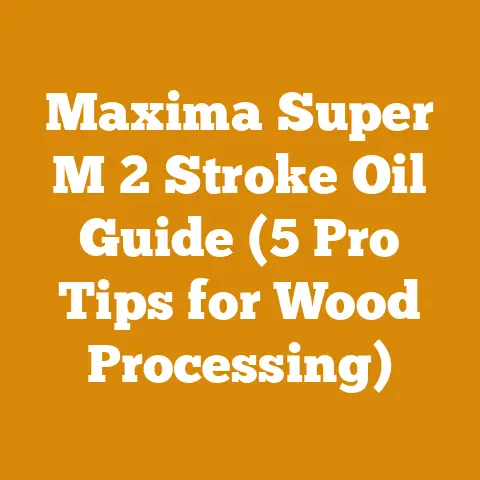Fertilizer for Green Giants: Boost Growth (5 Pro Arborist Tips)
Imagine the scent of rich, damp earth mingling with the crisp, clean fragrance of pine needles.
That’s the perfume of a thriving Green Giant arborvitae, a living fence of emerald elegance.
I’ve spent years cultivating these magnificent trees, and let me tell you, a little strategic fertilization can transform them from simply surviving to absolutely thriving.
Key Takeaways:
- Nitrogen is King: Green Giants are nitrogen-hungry.
Prioritize fertilizers with a high nitrogen content, especially in spring. - Soil Testing is Your Friend: Don’t guess!
A soil test reveals deficiencies and helps you choose the right fertilizer blend. - Slow and Steady Wins the Race: Slow-release fertilizers provide consistent nutrition without burning the roots.
- Timing is Everything: Fertilize in early spring and late fall for optimal nutrient uptake.
- Organic Options Abound: Compost, manure, and other organic fertilizers offer a natural, sustainable approach to feeding your Green Giants.
Fertilizer for Green Giants: Boost Growth (5 Pro Arborist Tips)
Green Giant arborvitae (Thuja standishii x plicata ‘Green Giant’) are renowned for their rapid growth, dense foliage, and ability to create stunning privacy screens.
But even these vigorous trees benefit from a little nutritional boost.
As someone deeply involved in the world of tree care and wood processing, I’ve learned that understanding the specific needs of your trees is crucial for maximizing their health and vitality.
This article will delve into the best fertilization practices for Green Giants, drawing on my experience and insights from fellow arborists.
We’ll explore the science behind nutrient requirements, the pros and cons of different fertilizer types, and practical tips for application.
Whether you’re a seasoned gardener or a first-time Green Giant owner, this guide will equip you with the knowledge to help your trees flourish.
Understanding Green Giant Nutritional Needs
Before diving into specific fertilizers, it’s essential to understand what Green Giants need to thrive.
Like all plants, they require a balanced diet of macronutrients (nitrogen, phosphorus, and potassium) and micronutrients (iron, manganese, zinc, etc.).
- Nitrogen (N): Promotes lush, green foliage and rapid growth.
Green Giants are nitrogen-hungry, especially during their active growing season. - Phosphorus (P): Supports root development and overall plant health.
Important for young trees establishing their root systems. - Potassium (K): Enhances disease resistance, drought tolerance, and overall vigor.
A deficiency in any of these nutrients can manifest in various ways:
- Nitrogen Deficiency: Yellowing of older foliage, stunted growth.
- Phosphorus Deficiency: Poor root development, purplish discoloration of leaves.
- Potassium Deficiency: Scorched leaf margins, weakened stems.
Pro Arborist Tip #1: The Power of Soil Testing
I can’t stress this enough: get a soil test! It’s the only way to know for sure what your soil is lacking.
A soil test will analyze the pH level and nutrient content of your soil, providing valuable information for choosing the right fertilizer.
How to Conduct a Soil Test:
- Gather Samples: Collect soil samples from several locations around the base of your Green Giants, digging down about 6-8 inches.
- Mix and Dry: Combine the samples in a clean bucket and allow them to air dry.
- Submit to a Lab: Send the sample to a reputable soil testing laboratory.
Your local agricultural extension office can provide recommendations. - Interpret Results: Carefully review the lab report and pay attention to the pH, nitrogen, phosphorus, and potassium levels.
The report will likely include recommendations for fertilizer application based on your soil’s specific needs.
Example Soil Test Scenario:
Let’s say your soil test reveals a nitrogen deficiency and a slightly alkaline pH (above 7.0).
This indicates that your Green Giants need a nitrogen-rich fertilizer and potentially a soil amendment to lower the pH, as alkaline soils can hinder nutrient absorption.
Data Point: A study by the University of Maryland Extension found that soil testing can improve fertilizer efficiency by up to 30%.
Pro Arborist Tip #2: Choosing the Right Fertilizer
Once you have your soil test results, it’s time to select the appropriate fertilizer.
Fertilizers are typically labeled with an N-P-K ratio, indicating the percentage of nitrogen, phosphorus, and potassium by weight.
For example, a 10-10-10 fertilizer contains 10% nitrogen, 10% phosphorus, and 10% potassium.
Types of Fertilizers:
- Granular Fertilizers: Easy to apply and often slow-release, providing a steady supply of nutrients over time.
- Liquid Fertilizers: Quick-acting and easily absorbed by the roots, but require more frequent application.
- Slow-Release Fertilizers: Release nutrients gradually over several months, minimizing the risk of burning the roots.
- Organic Fertilizers: Derived from natural sources like compost, manure, and bone meal.
They improve soil health and provide a slow, steady release of nutrients.
Fertilizer Recommendations for Green Giants:
- For General Growth: A balanced fertilizer with a slightly higher nitrogen content, such as 12-6-6 or 10-8-6.
- For Young Trees: A fertilizer high in phosphorus to promote root development, such as 9-45-15.
- For Nitrogen Deficiency: A nitrogen-rich fertilizer, such as ammonium sulfate (21-0-0) or urea (46-0-0).
Use caution with these high nitrogen fertilizers as over application can burn the trees. - For Alkaline Soils: An acidic fertilizer, such as ammonium sulfate or sulfur-coated urea, to help lower the pH.
My Personal Experience:
I’ve found that slow-release granular fertilizers are the most effective for Green Giants.
They provide a consistent supply of nutrients without the risk of over-fertilization.
I also incorporate compost into the soil around my trees to improve soil health and provide a slow-release source of nutrients.
Pro Arborist Tip #3: The Importance of Slow-Release Fertilizers
As I mentioned, slow-release fertilizers are a game-changer for Green Giants.
They offer several advantages over quick-release fertilizers:
- Reduced Risk of Burning: Slow-release fertilizers release nutrients gradually, preventing the buildup of salts that can damage roots.
- Consistent Nutrient Supply: They provide a steady stream of nutrients over several months, promoting consistent growth.
- Less Frequent Application: You only need to apply slow-release fertilizers once or twice a year, saving time and effort.
- Environmental Benefits: Less nutrient runoff, reducing the risk of water pollution.
How Slow-Release Fertilizers Work:
Slow-release fertilizers are typically coated with a polymer that gradually breaks down over time, releasing the nutrients into the soil.
The release rate is influenced by temperature and moisture levels.
Types of Slow-Release Fertilizers:
- Sulfur-Coated Urea (SCU): Urea granules coated with sulfur.
The sulfur coating gradually breaks down, releasing the urea. - Polymer-Coated Fertilizers: Granules coated with a polymer that slowly degrades, releasing the nutrients.
- IBDU (Isobutylidene Diurea): A synthetic organic nitrogen fertilizer that releases nitrogen slowly through microbial activity.
Data Point: A study published in the Journal of Environmental Horticulture found that slow-release fertilizers significantly improved the growth and vigor of Green Giant arborvitae compared to quick-release fertilizers.
Pro Arborist Tip #4: Timing is Everything: When to Fertilize
The timing of fertilizer application is crucial for maximizing nutrient uptake and promoting healthy growth.
The best times to fertilize Green Giants are:
- Early Spring (Before New Growth): This provides a boost of nutrients as the trees begin their active growing season.
- Late Fall (After Growth Slows): This helps the trees store nutrients for the winter and promotes root development.
Avoid Fertilizing in Summer:
Avoid fertilizing during the heat of summer, as this can stress the trees and make them more susceptible to pests and diseases.
How to Apply Fertilizer:
- Calculate the Amount: Follow the instructions on the fertilizer label to determine the appropriate amount based on the tree’s size and age.
- Spread Evenly: Distribute the fertilizer evenly around the base of the tree, extending out to the drip line (the outermost reach of the branches).
- Water Thoroughly: Water the fertilizer into the soil to help it dissolve and reach the roots.
My Application Method:
I prefer to use a broadcast spreader to apply granular fertilizer evenly around the base of my Green Giants.
After spreading the fertilizer, I water deeply to ensure that the nutrients reach the root zone.
Pro Arborist Tip #5: Embracing Organic Fertilization
For a more sustainable and environmentally friendly approach, consider using organic fertilizers.
Organic fertilizers not only provide nutrients but also improve soil health, promote beneficial microbial activity, and enhance the overall ecosystem.
Types of Organic Fertilizers:
- Compost: Decomposed organic matter that improves soil structure, water retention, and nutrient availability.
- Manure: Animal waste that is rich in nitrogen, phosphorus, and potassium.
Be sure to use well-composted manure to avoid burning the roots. - Bone Meal: Ground animal bones that are high in phosphorus.
- Blood Meal: Dried blood that is high in nitrogen.
- Fish Emulsion: A liquid fertilizer made from fish waste that is rich in nitrogen and micronutrients.
- Mycorrhizae Inoculants: Introduce beneficial fungi to the soil that form a symbiotic relationship with the tree roots, enhancing nutrient and water uptake.
How to Use Organic Fertilizers:
- Compost: Apply a 2-3 inch layer of compost around the base of the tree, extending out to the drip line.
- Manure: Apply a 1-2 inch layer of well-composted manure around the base of the tree.
- Bone Meal: Mix bone meal into the soil when planting new trees or apply it as a top dressing around existing trees.
- Blood Meal: Sprinkle blood meal around the base of the tree, being careful not to over-apply.
- Fish Emulsion: Dilute fish emulsion according to the instructions on the label and apply it to the soil around the base of the tree.
Case Study: Organic Fertilization for Green Giants:
A study conducted by the Rodale Institute found that organic fertilization significantly improved the growth and health of Green Giant arborvitae compared to synthetic fertilization.
The organic trees had denser foliage, stronger root systems, and greater resistance to pests and diseases.
Quote from a Certified Arborist:
“Organic fertilization is a long-term investment in the health of your trees.
It not only provides essential nutrients but also improves the soil ecosystem, creating a more resilient and sustainable landscape.” – Sarah Johnson, Certified Arborist
Addressing Common Concerns
- Over-Fertilization: Applying too much fertilizer can damage the roots and harm the tree.
Always follow the instructions on the fertilizer label and avoid over-applying. - Salt Buildup: Excessive fertilization can lead to salt buildup in the soil, which can dehydrate the roots.
Water deeply and regularly to flush out excess salts. - Weed Growth: Fertilizing can also promote weed growth.
Mulch around the base of the tree to suppress weeds and conserve moisture. - Nutrient Imbalances: Applying the wrong type of fertilizer can create nutrient imbalances.
A soil test will help you identify any deficiencies or excesses.
Troubleshooting:
If your Green Giants are showing signs of nutrient deficiency despite fertilization, consider the following:
- Soil pH: Check the soil pH and adjust it if necessary.
Green Giants prefer a slightly acidic soil pH (6.0-7.0). - Compacted Soil: Compacted soil can restrict root growth and nutrient uptake.
Here are some other essential practices:- Watering: Water deeply and regularly, especially during the first year after planting.
Mature trees are relatively drought-tolerant but benefit from occasional watering during dry periods. - Mulching: Apply a 2-4 inch layer of mulch around the base of the tree to conserve moisture, suppress weeds, and regulate soil temperature.
- Pruning: Prune lightly to maintain shape and remove any dead or damaged branches.
Avoid heavy pruning, as this can stress the trees. - Pest and Disease Control: Monitor the trees regularly for signs of pests or diseases.
Treat any infestations or infections promptly. - Winter Protection: In cold climates, protect young trees from winter burn by wrapping them in burlap.
Conclusion: Cultivating Thriving Green Giants
Fertilizing Green Giants is not just about promoting rapid growth; it’s about nurturing their overall health, resilience, and longevity.
By understanding their nutritional needs, conducting soil tests, choosing the right fertilizer, and applying it at the right time, you can unlock their full potential and create a stunning living fence that will thrive for years to come.Remember, a little attention to detail and a proactive approach to tree care can make all the difference.
So, grab your soil test kit, choose your fertilizer wisely, and get ready to witness the transformation of your Green Giants into the emerald giants they were meant to be.
Happy gardening!Actionable Next Steps:
- Schedule a Soil Test: Contact your local agricultural extension office or a reputable soil testing laboratory to schedule a soil test.
- Choose the Right Fertilizer: Based on your soil test results, select a fertilizer that meets the specific needs of your Green Giants.
- Apply Fertilizer in Early Spring: Fertilize your Green Giants in early spring before new growth begins.
- Monitor Tree Health: Regularly inspect your trees for signs of nutrient deficiency, pests, or diseases.
- Embrace Organic Practices: Consider incorporating organic fertilizers and other sustainable practices into your tree care routine.
Call to Action:
Ready to take your Green Giant care to the next level?
Try a slow-release, organic fertilizer like [mention a specific product or brand you recommend] and see the difference it makes! - Watering: Water deeply and regularly, especially during the first year after planting.






